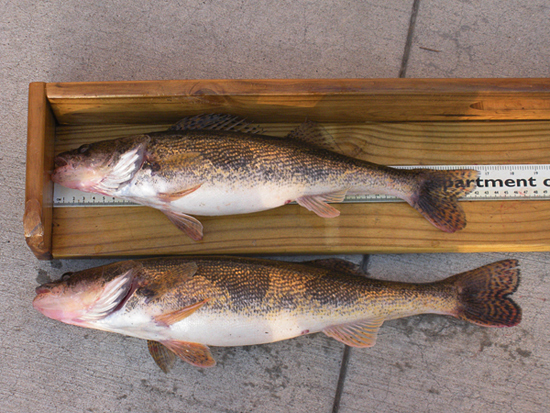By Lee McClellan
FRANKFORT, Ky. – Water temperatures in Kentucky rivers hovering in the high 30s to low 40s do not inspire confidence that it is a great time to go fishing.
However, for Kentucky sauger anglers, right now is glory time.
“I fished below Lock and Dam 6 on the Kentucky River last Saturday and I caught 12 sauger,” said Ryan Oster, federal aid coordinator for the Kentucky Department of Fish and Wildlife Resources. “The fish are there. The better fish I caught farther downstream from the dam.”
A five year stocking program commenced in 2006 placed hundreds of thousands of fingerling sauger in the Kentucky River from Lock and Dam 4 upstream to the headwaters. Excellent sauger fishing is now found throughout the river.

The next few weeks bring sauger below locks and dams not only on the Kentucky River, but the Ohio River, the Cumberland River below Lake Cumberland, the Tennessee River below Kentucky Lake and the Cumberland River below Lake Barkley. These areas offer anglers bank fishing opportunity as well as fishing from a boat.
Sauger hit orange, chartreuse, lime-green, white or pink curly-tailed grubs and soft plastic minnow imitators fished on the bottom just below these dams. Depending on current, you’ll need anywhere from a 1/4-ounce leadhead up to an ounce or more. If your lure isn’t regularly contacting bottom, then you likely aren’t catching sauger.
In addition to soft plastic lures rigged on leadheads, walleye fishing tactics using a spinner rig work for late winter sauger in the deep holes below dams.
The combination of bright plastic beads, a rotating blade, and a lively minnow is hard for sauger to resist. In turbid waters fish orange, yellow, white, chartreuse, pink or other bright-colored bead and blade combinations for added visibility.
Spinner rigs are easy to tie and inexpensive to make.
Start with a three-to-four-foot piece of 10-pound test monofilament or fluorocarbon line.
Tie on a single #4 walleye hook to the end of the leader with a clinch knot.
Thread two or three 5mm beads on the leader and slide them down to the hook. Sometimes anglers thread a small foam float (5/16 wide by 11/16 inches long) on the leader to make the rig more buoyant, so the hook is less likely to snag on the bottom.
Next, slip a stainless steel clevis through the eye of a blade and thread the leader through the small openings on both ends of the clevis. Slide the spinner blade assembly down the line so that it comes to rest against the beads or float.
The final step is to cut the leader to the desired length and tie a loop knot on the free end of the leader. Experiment with color, blade size and style, either Colorado or Indiana, to find out which rig is most effective on a given day.
Attach the rig to the snap at the top of the bottom bouncer. When fishing in rivers in the spring about 1 1/2 to 2 1/2ounces of lead is heavy enough to keep your rig on the bottom in moderate current.
Fishing success is all about presentation. Motor upstream to the dam, then let the boat drift through the area you want to fish. By keeping the weight in contact with the bottom, the baited rig will drift just a few inches off the bottom, the depth needed to entice a bite from bottom-hugging sauger.
Over the next few years, Kentuckians may catch sauger in the Green River downstream of Green River Lake, in the Salt River below Taylorsville Lake and in the middle stretch of the Barren River. The fisheries division of Kentucky Fish and Wildlife stocked 188,000 fingerling sauger in the Green River, 32,000 in the Salt River and 50,000 in the Barren River over the past two years.
“We hope to establish a viable reproducing population of sauger in these rivers,” said Gerry Buynak, assistant director of fisheries for Kentucky Fish and Wildlife. “We hope to have sauger fishing right in downtown Bowling Green.”
Remember the current license year expires Feb. 29. If you plan to fish after March 1, you’ll need to buy a new fishing license, available in the sporting goods section of department stores and tackle shops. You may buy one by visiting the Kentucky Fish and Wildlife homepage at fw.ky.gov or by calling 1-877-598-2401.
Author Lee McClellan is an award-winning associate editor for Kentucky Afield magazine, the official publication of the Kentucky Department of Fish and Wildlife Resources. He is a life-long hunter and angler, with a passion for smallmouth bass fishing. Author Art Lander Jr. has been writing about the outdoors since the 1970s. He is a staff writer for Kentucky Afield Magazine.
Media Contact: Art Lander or Lee McClellan 1-800-858-1549, ext. 4443


Be the first to comment